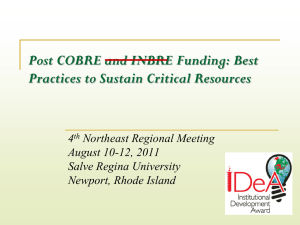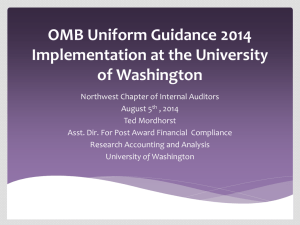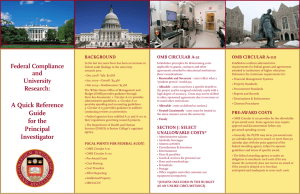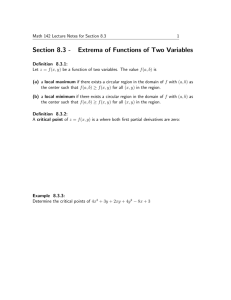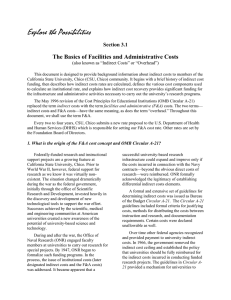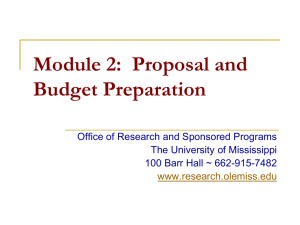BRIEF HISTORY OF CIRCULAR A-21
advertisement
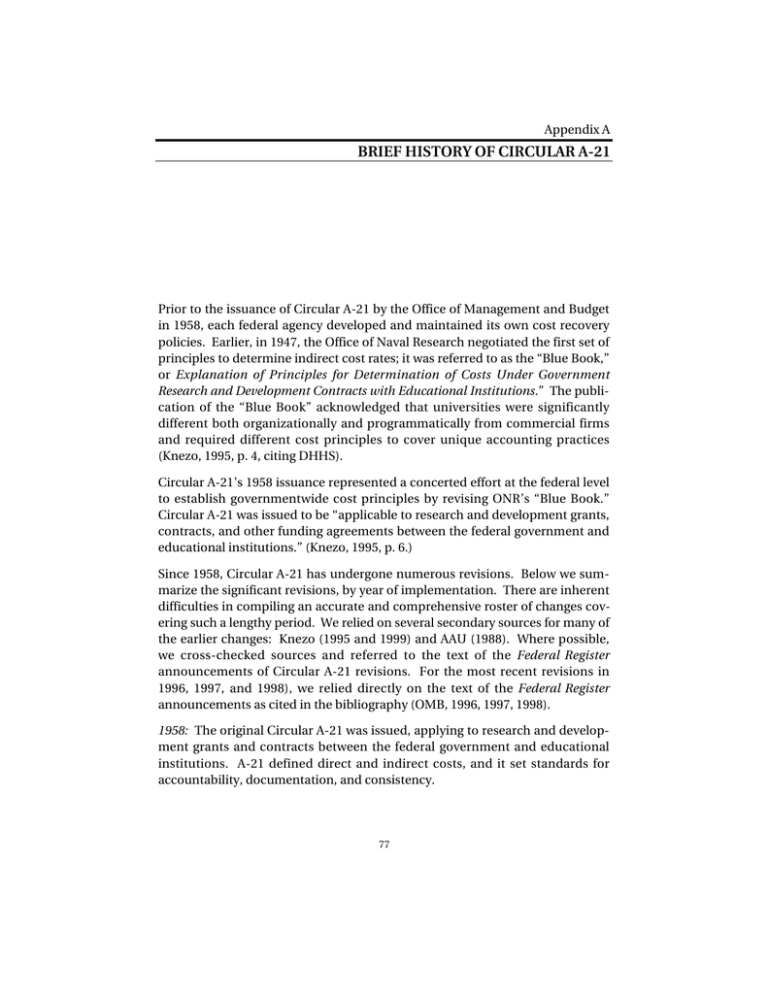
Appendix A BRIEF HISTORY OF CIRCULAR A-21 Prior to the issuance of Circular A-21 by the Office of Management and Budget in 1958, each federal agency developed and maintained its own cost recovery policies. Earlier, in 1947, the Office of Naval Research negotiated the first set of principles to determine indirect cost rates; it was referred to as the “Blue Book,” or Explanation of Principles for Determination of Costs Under Government Research and Development Contracts with Educational Institutions.” The publication of the “Blue Book” acknowledged that universities were significantly different both organizationally and programmatically from commercial firms and required different cost principles to cover unique accounting practices (Knezo, 1995, p. 4, citing DHHS). Circular A-21’s 1958 issuance represented a concerted effort at the federal level to establish governmentwide cost principles by revising ONR’s “Blue Book.” Circular A-21 was issued to be “applicable to research and development grants, contracts, and other funding agreements between the federal government and educational institutions.” (Knezo, 1995, p. 6.) Since 1958, Circular A-21 has undergone numerous revisions. Below we summarize the significant revisions, by year of implementation. There are inherent difficulties in compiling an accurate and comprehensive roster of changes covering such a lengthy period. We relied on several secondary sources for many of the earlier changes: Knezo (1995 and 1999) and AAU (1988). Where possible, we cross-checked sources and referred to the text of the Federal Register announcements of Circular A-21 revisions. For the most recent revisions in 1996, 1997, and 1998), we relied directly on the text of the Federal Register announcements as cited in the bibliography (OMB, 1996, 1997, 1998). 1958: The original Circular A-21 was issued, applying to research and development grants and contracts between the federal government and educational institutions. A-21 defined direct and indirect costs, and it set standards for accountability, documentation, and consistency. 77 78 Paying for Research Facilities and Administration Institutions receiving less than $250,000 in awards were permitted to use a simplified method (short form) to calculate and allocate indirect costs. 1961 and 1962: Revisions of A-21 clarified and refined methods used in identifying, classifying, and distributing indirect costs. 1967 and 1968: Changes in A-21 involved modification of effort-reporting requirements. 1969: The federal funding limit was raised to $1 million for universities that wished to use the simplified method (short form). Principles and guidelines to be used in determining costs for training and educational service agreements were established. 1973: The administration of the Circular A-21 was transferred to the General Services Administration from the OMB. Circular A-21’s name changed to federal Management Circular 73-8. 1976: Standards for allowable costs were made more precise. 1979: OMB resumed administration of Circular 73-8 and the title reverted back to Circular A-21. Modified total direct costs were established as the basis for calculating the distributions of indirect costs among projects. The threshold was raised to $3 million in direct costs for institutions wishing to use the simplified method (short form). 1982: Revisions eased effort-reporting requirements to cover only work funded by the federal government, rather than all research, teaching, and administration. Effort reports were now allowed to be filled out by persons other than the researchers. The interest costs of debt directly associated with buildings and equipment supporting research were made allowable. 1986: Fixed allowance created for departmental administration (specifically of academic department heads, faculty, and other professional staff) that could be charged to research at 3.6 percent of MTDC. (The allowance was first set at a rate of 3.0 percent in June 1986 and revised to 3.6 percent in December 1986.) 1991: Costs in the administrative category were subject to a 26 percent cap. Ambiguities in interpretation of the circular to prevent shifting capped indirect costs to uncapped costs were removed. Brief History of Circular A-21 79 Some costs were excluded, such as alcoholic beverages; entertainment; alumni activities; housing and personal expenses of officers; defense and prosecution of criminal and civil proceedings, claims, appeals, and patent infringements; and trustees’ travel. Assurances were required from universities that reimbursement for buildings would be used exclusively for research facility expenditures. 1993: Seven categories of cost categories (pools) were aggregated into two general categories: facilities and administration. An option was created for schools to claim an allowance of 24 percent of MTDC for the administrative portion of indirect costs, or a percentage equal to 95 percent of the most recently negotiated rate for administrative cost pools, whichever is less. If schools elected to use the lower cap, they would not be required to prepare the paperwork necessary to document rates. The time that predetermined fixed indirect costs rates could be used was extended from three to four years. Government cost accounting standards and required disclosure of cost accounting practices were imposed. The threshold in direct costs for institutions wishing to use the simplified method (short form) was raised to $10 million. 1996: “Facilities and administrative costs” replaced the phrase “indirect costs.” Four cost accounting standards applicable to educational institutions were incorporated into A-21. Institutions receiving more than $25 million in federal sponsored agreements subject to A-21 were required to disclose their cost accounting practices by the submission of a DS-2 Disclosure Statement prescribed by the Cost Accounting Standards Board. Use allowance and depreciation methodologies were clarified. The threshold for capitalizing equipment was raised from $500 to $5,000 (or the institution’s own selected capitalization threshold for its own accounting records, if lower). Employee dependent tuition benefits were disallowed in fringe benefit calculations. Interest costs on capital assets of more than $500,000 must be supported by an analysis of lease versus purchase. The interest costs of the cheaper alternative are allowable. 80 Paying for Research Facilities and Administration The F&A rates in effect at the start of a sponsored agreement must be used over the life of that agreement. Award levels for future years of a single agreement may not be adjusted based on changes in F&A rates. The negotiation responsibilities for cognizant agencies were outlined. Proposed elimination of special cost studies to allocate utility, library, and student services costs, effective 1998. (This provision was amended in 1998.) 1997: Conditional exemptions from OMB’s grants management requirements were established for certain federal grants programs with statutorily authorized consolidated planning (for certain state-administered nonentitlement grants programs). 1998: Revisions were made establishing review and documentation requirements to ensure the reasonableness of the costs of large research facilities. Utility costs adjustment recovery: 1.3 percent rate adjustment in lieu of special cost studies for 66 named universities, with review in 2002. Elimination of special studies to determine library cost deferred. Guidance on the calculation of depreciation and use allowances on buildings and equipment added. Trustees’ travel expenses were allowable. Allowed universities that use the simplified method (short form) to use either salaries and wages or MTDC as a base to distribute their facilities and administrative costs.
